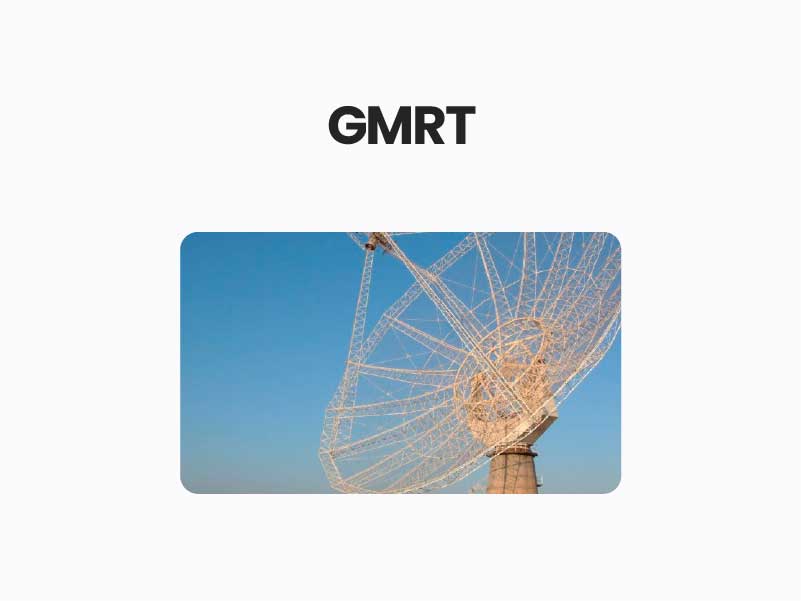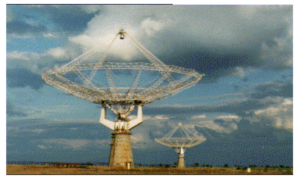Companion@360 → 7 Month programme to sharpen your writing skills → REGISTER NOW

GIANT METREWAVE RADIO TELESCOPE
NCRA, a centre of the school of natural sciences of the TIFR, has set up a unique facility, the Giant Metrewave Radio Telescope for radio astronomical research at metre wavelengths. GMRT is a very versatile instrument for investigating a variety of radio astrophysical problems ranging from nearby Solar system to the edge of observable Universe.
- The Giant Metrewave Radio Telescope (GMRT) has been selected as a ‘Milestone’ facility by the U.S.-based Institute of Electrical and Electronics Engineers (IEEE), which is the world’s largest technical professional organisation dedicated to advancing technology in all areas related to electrical and electronics engineering.
- Considering the global impact of GMRT with users from over 40 countries and the fact that it was designed and built entirely in India, the IEEE’s India office and its Pune branch had initiated the proposal to nominate GMRT for this recognition.
- “The GMRT has produced important discoveries in domains such as pulsars, supernovae, galaxies, quasars, and cosmology, greatly enhancing our understanding of the Universe.”
- “It is also a fitting tribute to the late Prof. Govind Swarup, who was the driving force behind the GMRT, and all the team members whose efforts over the last 30 years or so made the GMRT a reality, culminating in the successful upgrade of the facility.
Significance of Giant Metrewave Radio Telescope:
- NCRA has set up a unique facility for radio astronomical research using the metre wavelengths range of the radio spectrum, known as the Giant Metrewave Radio Telescope (GMRT), it is located at a site about 80 km north of Pune.
- GMRT consists of 30 fully steerable gigantic parabolic dishes of 45m diameter each spread over distances of upto 25 km.
- GMRT is one of the most challenging experimental programmes in basic sciences undertaken by Indian scientists and engineers.
- GMRT is an indigenous project. The construction of 30 large dishes at a relatively small cost has been possible due to an important technological breakthrough achieved by Indian Scientists and Engineers in the design of light-weight, low-cost dishes.
- The design is based on what is being called the `SMART’ concept – for Stretch Mesh Attached to Rope Trusses.
- Apart from the novel low-cost design of the parabolic dishes, the instrument has state-of-the-art electronics systems developed indigenously and consisting of the following main sub units.
-
- Antenna feeds at six different frequency bands between 50 MHz and 1500 MHz, having good polarization characteristics as well as simultaneous multiband operation.
-
- Low-noise amplifiers, local oscillator synthesizers, mixers, IF amplifiers.
-
- Optical fibres linking the entire array with the CEB. These are used both for the telemetry signals and local oscillator phase reference communication between the CEB and each antenna base.
-
- A digital 2,30,000-channel FX-type correlator providing upto 128 spectral channels and covering a maximum bandwidth of 32 MHz
Ojectives:
- To detect the highly redshifted spectral line of neutral Hydrogen expected from protoclusters or protogalaxies before they condensed to form galaxies in the early phase of the Universe and
- To search for and study rapidly-rotating Pulsars in our galaxy.
Goals of GMRT:
- Galactic and Extragalactic Radio Sources : Because of its large collecting area and wide frequency coverage, GMRT will be an invaluable and highly versatile instrument for studying many other problems at the frontiers of astrophysics.
- Pulsars and Neutron Stars : GMRT should also be an ideal instrument for the study of Pulsars (rapidly rotating neutron stars with extremely high densities of about 200 million tons per cubic cm).
- Epoch of Galaxy Formation : Theories of the formation of structure in the Big-Bang Universe predict the presence of proto galaxies or proto clusters of galaxies made up of clouds of neutral Hydrogen gas before their gravitational condensation into galaxies.
Read Notes by UPSC Topper Ravisankar Sarma


